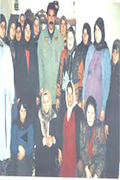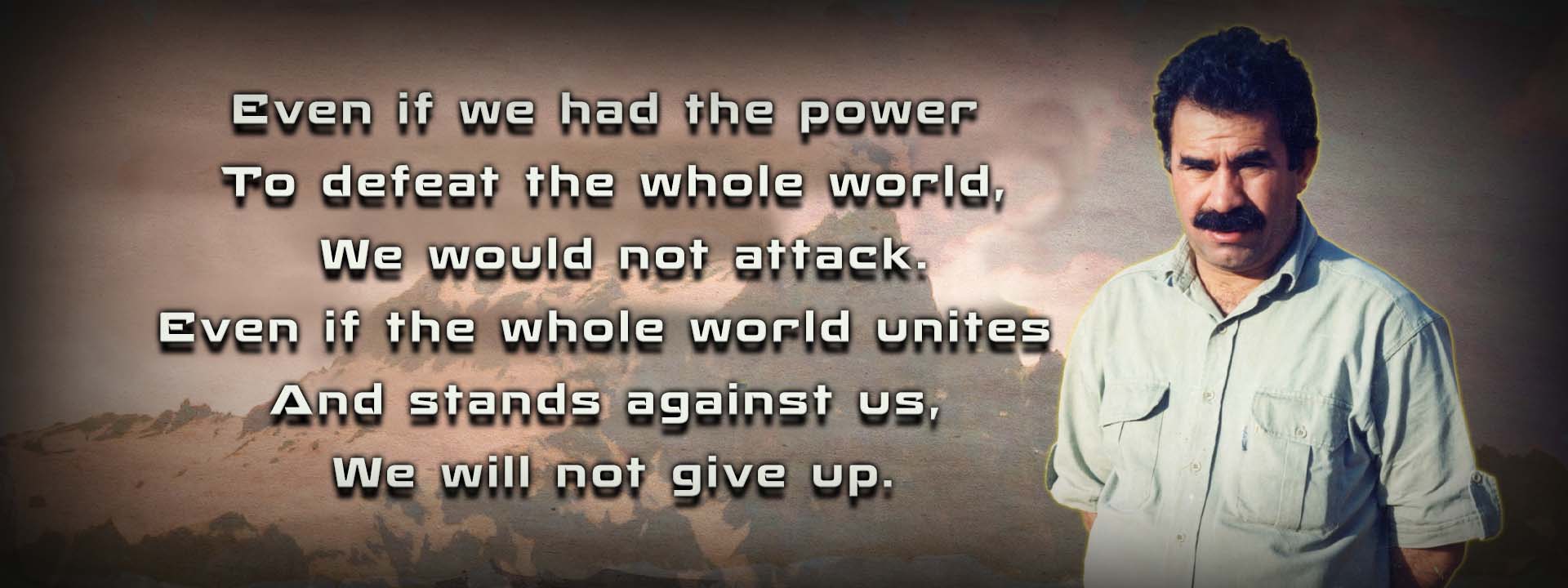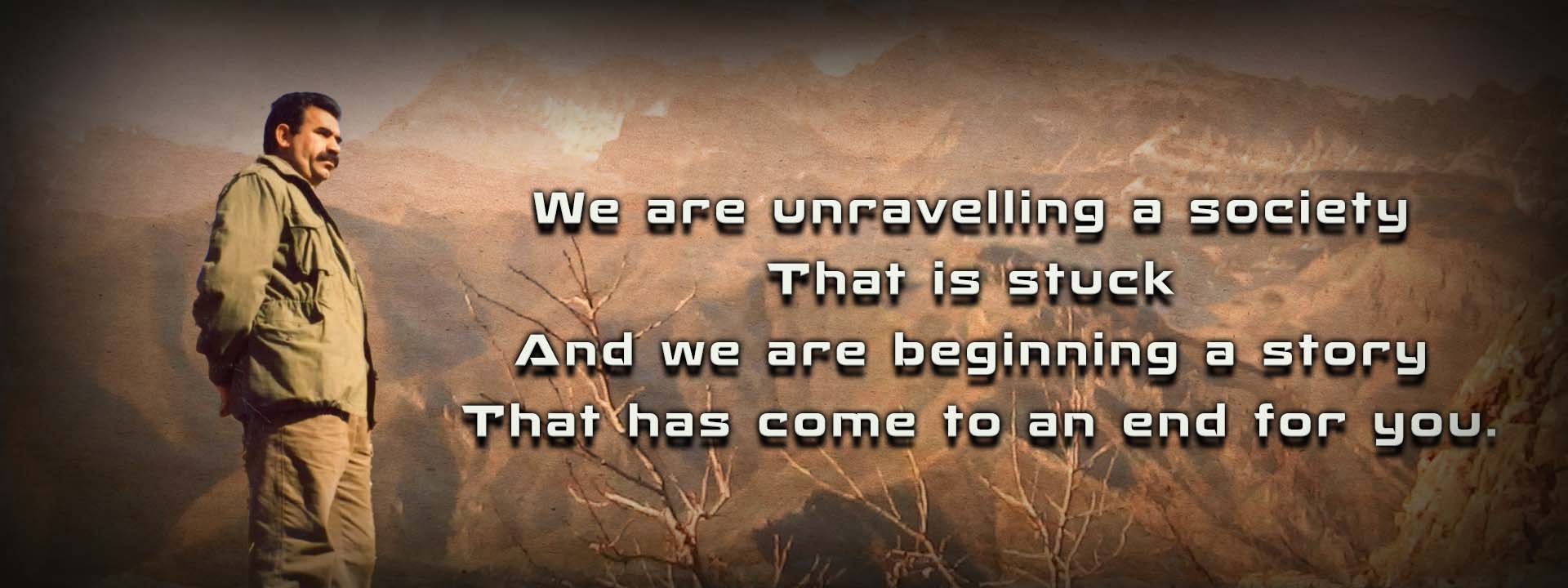 The history of the woman means the history of cereals, small size cattle, fruit trees, village households, weaving, the pickaxe and domestic mills.
The history of the woman means the history of cereals, small size cattle, fruit trees, village households, weaving, the pickaxe and domestic mills.
In the course of a long process, the Kurdish movement has created structures in which women are more involved, and there are more women in leadership positions, than in most comparable social movements in the Middle East and indeed elsewhere. But both organisationally and in terms of theory, the active participation of women has created something more than strengthening the numbers.
Several years ago, Ocalan said, "... I find it quite crucial to develop a thinking which expressly includes the female dimension, and gradually arrive at an ideology guided by a female viewpoint and set up a corresponding form of organisation. This is relevant to the entirety of issues before us, from tackling the problems we are facing in war to creating the conditions for a peace based on freedom."
The gender struggle, the devastating effects of both the feudal traditional and the capitalist outlook on family and sexuality, and the possibilities of liberating social relations between women and men, were always central issues to the discourse of Ocalan and the PKK, and accordingly much attention was directed at organising women. But it is in his recent book that Ocalan concentrates on the historic and ideological ramifications of the creation of patriarchy in ancient Mesopotamia.
"The Neolithic village revolution was the second stage in the process of human socialisation after the formation of more or less stable units of people using language and tools. This particular revolution that began perhaps as far back as twelve thousand years ago, was the biggest step forward in social formation. The influence of this advance upon the development of human kind is ongoing in terms of material and moral institutions as well as mental predispositions. The Neolithic revolution, and the sedentiary rural society based on this, brought about many things that have continuously been and still are feeding civilisation. Agriculture and the domestication of animals, thoughts, lingual structures and concepts referring to such products and the relevant tools, the discovery and use of metal ores [...] are but a few of the.
Religious worship was predominantly centred around the mother goddess. In nearly all the settlements of this period there were found numerous statuettes that may be described as mother goddesses. The representation of the woman manifested itself in the stars and moon but was mainly represented as the mother of the local natural forces. It was woman’s labour that created agriculture and tamed animals. As the childbearing mother, the woman became sacred as the creative force of life. Nature is the mother earth. The representation of woman as the crop-yielding force of trees, plants and nature in natural characterisations bears a deep meaning.
The role of the male may have been powerful where hunting was the main form of livelihood. But with the demise of hunting, the male species seemed to have lost importance. The history of the woman means the history of cereals, small size cattle, fruit trees, village households, weaving, the pickaxe and domestic mills. The basis of respect was labour and production. This is the history of produce created by labour, of socially reared children and established households. This also meant a transition from sign language to a richly expressed language, concepts based on significant productive instruments. Therefore this means a transition in the creation of human intellect. When around the 4th millenium B.C. ploughing [oxen-drawn plough] began to play an increasing role in agriculture and pastoralism became more important, this was at the expense of woman’s role in production. Women were progressively confined to the house and so they remained until the present day. In this context, unarguably and with absolute certainty, the conceptualisation and inscription of history neglected women’s role in history. The fundamental reason for a history without women was that due to the progression of male dominance in parallel with the process of civilization, women were gradually excluded from the institutions of sub- and superstructure of class society. The result of this is that our entire understanding of history rests on a distortion that in turn is rooted in the man-made inequality of the genders.
The matriocentric religion of Neolithic society exerted an enduring impact on numerous later varieties of secret (mystical) philosophies. Whilst these religious formations reflected the reaction of the oppressed classes against official religion on the one hand, they also represented the female gender, her life characteristics, the religion of nature, the friendship between human and god, and her peaceful characteristics on the other. Overall, they are marked by a more worldly and secular approach. Throughout history most secret centres of worship and heterodox esoteric orders have attempted to retain a certain affinity to the female gender, but notwithstanding that they never managed to liberate themselves from the intense exploitation of the female gender inherent in social roles and codes attached to religious beliefs. The backwardness of technology and science have much to account for this. These religious orders can be regarded as the power of opposition in the name of the oppressed in the Primordial and Middle Ages. Despite their being widespread throughout history, the fact that their leaders were vilified by cruel persecution or bought off, subjected them to considerable degeneration, torture and surveillance. However, it is also true that since Neolithic society, and until the present day, religious orders and sects in opposition have largely reflected the beliefs, resistance and lifestyles of wretched and exploited sections of humanity.
History is the history of man who gains power as class society emerges. The hegemonic class character emerges simultaneously with the hegemonic male character. [...] Until the present day the hegemonic male character has not left us much possibilities to deal with gender issues on a scientific basis. There are even stricter taboos on gender issues than there are on religion. [...] The fact that throughout the course of history woman has been deprived of her identity and personality and has been held as the permanent prisoner of man has had more devastating effects than even the creation of social classes. The imprisonment of woman can serve as a measure for overall slavery and humiliation, a criterion for the distortion of society with lies, theft and brutality, a measure of pollution and servility. To reverse this history will inexorably have intricate social consequences. The rebirth of free woman will inevitably result in general emancipation, enlightenment and justice."
Leader APO



